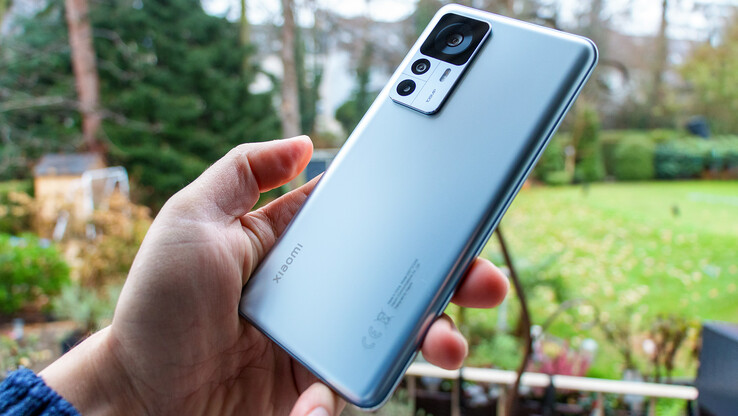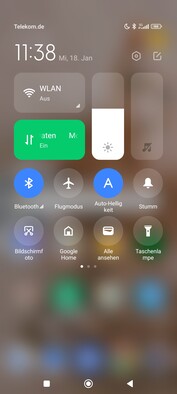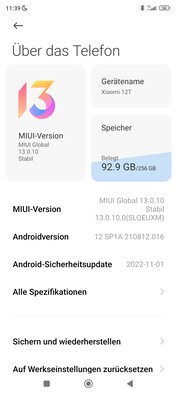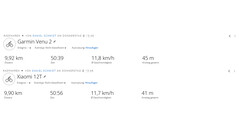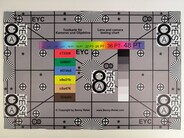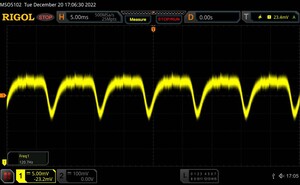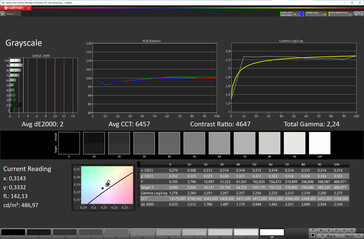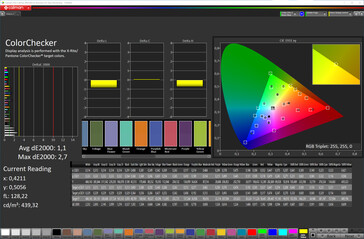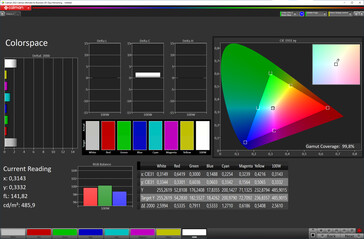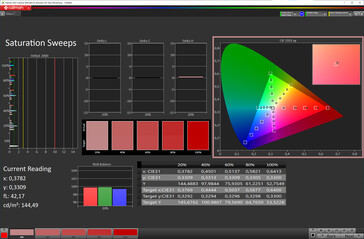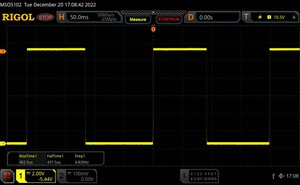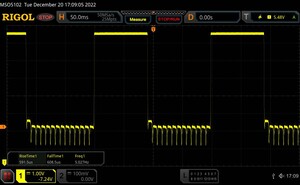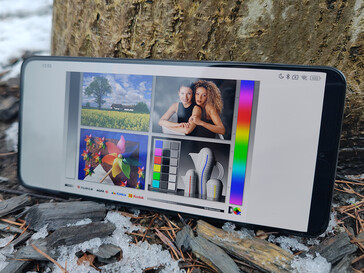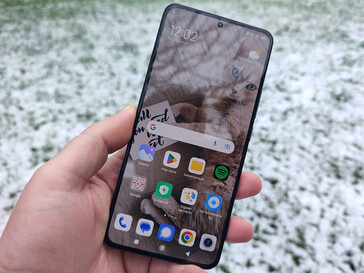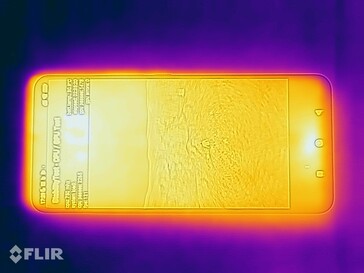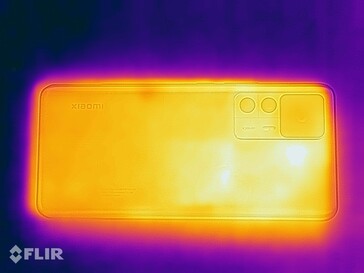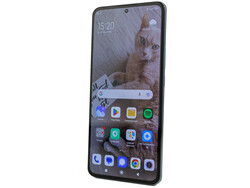Xiaomi 12T 5G review - Top of the range smartphone at an attractive price
The Xiaomi 12T 5G follows the Xiaomi 11T and is the smaller sibling of the 12T Pro 5G. The basic details read very similarly to those of its predecessor. Both devices opt for a 6.67-inch large AMOLED display with up to 120 Hz. Additionally, they have 8 GB of RAM at their disposal and come with a choice of either 128 or 256 GB internal memory. The heart of the triple-camera is a 108 MPix sensor and both devices are poweréd by 5000 mAh batteries.
The Xiaomi 12T 5G uses a newer and more powerful MediaTek-SoC. Although the amount of RAM is identical, in LPDDR5 the 12T possesses a more modern standard. The fast-charging technology has received a substantial upgrade which now supports up to 120 watts. However, regarding the camera, our review demonstrates that just because something is newer it doesn't automatically make it better.
In terms of price, the Xiaomi smartphone starts with an RRP of around 490 US dollars for the smaller storage version, with the 256 GB model coming in at an additional 40 dollars.
Possible competitors compared
Rating | Date | Model | Weight | Drive | Size | Resolution | Price |
|---|---|---|---|---|---|---|---|
| 86.4 % v7 (old) | 01 / 2023 | Xiaomi 12T Dimensity 8100, Mali-G610 MP6 | 202 g | 256 GB UFS 3.1 Flash | 6.67" | 2712x1220 | |
| 86.6 % v7 (old) | 10 / 2021 | Xiaomi 11T Dimensity 1200, Mali-G77 MP9 | 203 g | 128 GB UFS 3.1 Flash | 6.67" | 2400x1080 | |
| 88.5 % v7 (old) | 11 / 2022 | Google Pixel 7 Tensor G2, Mali-G710 MP7 | 197 g | 128 GB UFS 3.1 Flash | 6.30" | 2400x1080 | |
| 89.3 % v7 (old) | 05 / 2022 | Samsung Galaxy S22 Exynos 2200, Xclipse 920 | 167 g | 128 GB UFS 3.1 Flash | 6.10" | 2340x1080 | |
| 87.4 % v7 (old) | 10 / 2022 | Motorola Edge 30 Fusion SD 888+ 5G, Adreno 660 | 172 g | 128 GB UFS 3.1 Flash | 6.55" | 2400x1080 | |
| 87.4 % v7 (old) | 03 / 2022 | Realme GT 2 Pro SD 8 Gen 1, Adreno 730 | 189 g | 256 GB UFS 3.1 Flash | 6.70" | 3216x1440 |
Case - Xiaomi 12T only with Gorilla Glass 5
The Xiaomi 12T 5G is available in three color variants: blue, black, and silver, the color of our test device. Xiaomi has stayed true to its predecessor's basic design with only the camera set-up having received an optical makeover but continuing to jut out.
The smartphone has made a backward step concerning the glass front panel with the implementation of the older Corning Gorilla Glas 5 rather than the current Vitus type used in the 11T. The rear panel now comes with matte glass which is curved at the sides and is otherwise not specified by Xiaomi. A very stylish look but fingerprints remain clearly visible.
The device impresses with its high-quality finish. The partially matte aluminum frame has a premium look and despite its heavy weight, the 12T 5G feels good in the hand, due to the rear panel's curved sides. The side buttons can be easily reached with only left-handers requiring a slight grip readjustment to increase the volume. Although gaps are tight and even, the device creaks considerably when twisted.
The SIM slot closes flush to the frame and possesses a small rubber seal on the inside. However, the Xiaomi 12T 5G offers nothing in the way of certified dust or water protection.
Features - Xiaomi smartphone with USB 2.0
The Xiaomi 12T 5G has a USB-2.0 port, which supports OTG and enables the connection of peripherals and storage media. Memory expansion via a microSD card is not possible.
As with very few smartphones in this price category, the 12T also comes without a radio receiver or an integrated audio jack. Anyone wishing to use wired headphones can only do so with the help of a USB adapter. However, an IR blaster is still on board and can be used to control multimedia devices, cameras, and air conditioning systems. In addition to NFC, the device also comes with modern Bluetooth 5.3.
Software - The Xiaomi 12T will get Android 15
The Xiaomi 12T 5G is shipped with Android 12 and MIUI 13. The manufacturer has promised three big Android updates for the 12T series ensuring the 12T will also receive Android 15 and security patches continuing for another year. However, the update intervals are relatively large as our test device was still on MIUI 13.0.10 from November 1, 2022, at the conclusion of our test. Xiaomi is most likely aiming for quarterly updates.
Typically for MIUI, the system is very restrictive when it comes to energy management. For anyone wishing to ensure that push notifications from important apps are always received, the appropriate restrictions should be lifted in each app's settings.
Communication and GNSS - Stable WiFi 6 and good GPS tracking
The Xiaomi 12T 5G boasts similar communication features to that of its predecessor apart from the newer Bluetooth standard. The smartphone supports WiFi 6 but not yet 6E and can therefore only use the 2.4 and 5.0 GHz bands. The transfer speeds to our Asus ROG Rapture GT-AXE11000 reference router and high and very stable.
On the go, the 12T connects the network with 5G-Sub6 and offers a decent frequency range which should not result in any connection bottlenecks within Europe.
| Networking | |
| Xiaomi 12T | |
| iperf3 receive AXE11000 | |
| iperf3 transmit AXE11000 | |
| Xiaomi 11T | |
| iperf3 transmit AX12 | |
| iperf3 receive AX12 | |
| Google Pixel 7 | |
| iperf3 receive AXE11000 | |
| iperf3 transmit AXE11000 | |
| iperf3 transmit AXE11000 6GHz | |
| iperf3 receive AXE11000 6GHz | |
| Samsung Galaxy S22 | |
| iperf3 receive AXE11000 | |
| iperf3 transmit AXE11000 | |
| Motorola Edge 30 Fusion | |
| iperf3 receive AXE11000 | |
| iperf3 transmit AXE11000 | |
| iperf3 transmit AXE11000 6GHz | |
| iperf3 receive AXE11000 6GHz | |
| Realme GT 2 Pro | |
| iperf3 receive AXE11000 | |
| iperf3 transmit AXE11000 | |
| Average of class Smartphone | |
| iperf3 receive AXE11000 | |
| iperf3 transmit AXE11000 | |
| iperf3 transmit AXE11000 6GHz | |
| iperf3 receive AXE11000 6GHz | |
The Xiaomi 12T 5G supports all global satellite networks and their associated frequency bands; including the Indian NavIC as well as SBAS. Outdoors, the Satfix took place swiftly and accurately whereby indoors it can take up to half a minute but with almost similar precision.
On a bike tour, we put the Xiaomi smartphone head-to-head with the Garmin Venu 2. The recorded total distance of nearly ten kilometers deviated by only 20 meters. The detailed route plan revealed a few inaccuracies on the part of the 12T but still managed convincing location performance.
Phone functions and call quality
The Xiaomi 12T 5G supports Dual-SIM with two Nano SIM cards, VoLTE, and WiFi calls. However, the device doesn't integrate SIP accounts and also third-party apps may have to be used instead.
When held to the ear, the smartphone's call quality is good but noise cancellation is only sufficient for quieter environmental noise with the device soon reaching its limits on busy streets or amongst large gatherings of people. The speaker mode does its job adequately, only reverberates slightly, and has a usable microphone range.
Cameras - Xiaomi smartphone with weak additional lenses
In terms of resolution, the front-facing camera has increased slightly with 20 MPix at its disposal but only using it for pixel-binning. Unfortunately, these many pixels are not reflected in inordinately good image quality. Even though the imaging performance is rock solid and details are missing in places, generally we liked the cooler reproduction. At best, videos are recorded in Full HD at 60fps.
At the technological heart is a 108 MPix photo sensor: the Samsung ISOCELL HM6. This is a little smaller than the HM2 in the 11T, which is also reflected in smaller pixels. In contrast, Samsung has increased the autofocus pixel density to be able to capture moving objects better. Using pixel binning, nine neighboring pixels are combined into one super pixel helping improve low-light performance. During testing, the imaging performance was impressive and delivered appealing results. The AI doesn't overly sharpen images and colors are not over-saturated. In dark scenes, the subject is captured properly but certain areas appear muddy and pixelated.
Both of the triple camera's additional lenses consist of an ultra-wide-angle lens as well as a macro lens. The latter still had 5 MPix in the 11T and now has to make do with 2 MPix. The ultra-wide-angle lens does its job well and is a little short on detail, but the macro is quite simply poor.
At best, the Xiaomi 12T 5G records videos in Ultra HD (maximum 30fps). With this sensor, theoretically, 8K at 24fps or 4K at up to 120fps ought to be possible. However, the SoC's ISP seems to be the limiting factor here.
Macro shots with the Xiaomi 12T
Image comparison
Choose a scene and navigate within the first image. One click changes the position on touchscreens. One click on the zoomed-in image opens the original in a new window. The first image shows the scaled photograph of the test device.
HauptkameraHauptkameraUltraweitwinkel5-facher ZoomLow-LightColor reproduction is more saturated under controlled lighting conditions. In particular, the red and green tone's DeltaE is considerably higher than 10.
The Xiaomi 12T displays an accurate representation of the test chart. Only at full magnification does it become noticeable that a few details are lost, even in the center of the image. However, this effect increases only slightly towards the edge of the image.
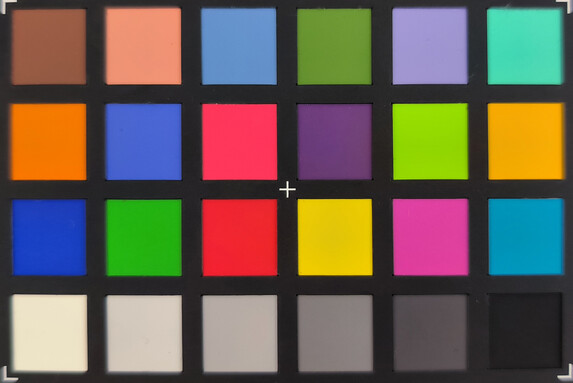

Accessories and guarantee - Now including a 120W charger
The Xiaomi 12T 5G only comes with a one-year guarantee that cannot be extended. The guarantee obligation remains unaffected by this.
For a 2022 smartphone, the device comes packed with an extensive range of extras. These include a modular 120-watt charger, a USB cable (type-A to type-C), a SIM tool, a transparent silicon protective case as well as the usual paperwork in several languages. Unlike last year, an audio jack adapter is not included.
Input devices & operation - Touchscreen with a high sampling rate
The Xiaomi 12T 5G's capacitive touchscreen has a sampling rate of up to 480 Hz and can recognize up to ten touches at the same time. The display already comes with a factory-fitted screen protector. The display is smooth and responsive and input responds quickly and precisely.
An integrated in-display fingerprint sensor takes care of biometric security, delivering reliable recognition rates and unlocking the phone quickly. Alternatively or additionally, less secure facial recognition can be set up via the front-facing camera.
The vibration motor runs quietly and provides good haptic feedback.
The Xiaomi 12T 5G has a bright, 120 Hz OLED
In terms of the display, no compromises have had to be made compared to the Xiaomi 12T Pro, as they are identical in construction. The 6.67-inch AMOLED panel employs an unusual resolution but offers higher pixel density. In addition, the Xiaomi smartphone supports the most common HDR standards, with only Dolby Vision missing.
With the activated ambient light sensor, brightness is very high with a pure white display and manages to reach an average of 914 cd/m². With an even distribution of light and dark areas, (APL18) this value climbs to 1118 cd/m². For anyone only wishing to regulate the brightness manually, 502 cd/m² are available.
OLED flickering isn't particularly noticeable as the 12T operates with a constant DC dimming mode over the entire brightness range. With the oscilloscope, we were only able to measure consistent flickering at the display refresh rate. A time-lapse look through the microscope revealed that no temporal dithering is used.
| |||||||||||||||||||||||||
Brightness Distribution: 98 %
Center on Battery: 915 cd/m²
Contrast: ∞:1 (Black: 0 cd/m²)
ΔE ColorChecker Calman: 1.1 | ∀{0.5-29.43 Ø4.78}
ΔE Greyscale Calman: 2 | ∀{0.09-98 Ø5}
99.8% sRGB (Calman 2D)
Gamma: 2.24
CCT: 6457 K
| Xiaomi 12T AMOLED, 2712x1220, 6.7" | Xiaomi 11T AMOLED, 2400x1080, 6.7" | Google Pixel 7 OLED, 2400x1080, 6.3" | Samsung Galaxy S22 AMOLED, 2340x1080, 6.1" | Motorola Edge 30 Fusion pOLED, 2400x1080, 6.6" | Realme GT 2 Pro AMOLED, 3216x1440, 6.7" | |
|---|---|---|---|---|---|---|
| Screen | -23% | 3% | -17% | -2% | -85% | |
| Brightness middle (cd/m²) | 915 | 781 -15% | 936 2% | 853 -7% | 954 4% | 740 -19% |
| Brightness (cd/m²) | 914 | 782 -14% | 947 4% | 858 -6% | 961 5% | 732 -20% |
| Brightness Distribution (%) | 98 | 94 -4% | 95 -3% | 96 -2% | 98 0% | 98 0% |
| Black Level * (cd/m²) | ||||||
| Colorchecker dE 2000 * | 1.1 | 2 -82% | 1.3 -18% | 1.9 -73% | 1.5 -36% | 3.25 -195% |
| Colorchecker dE 2000 max. * | 2.7 | 2.9 -7% | 2.7 -0% | 3.2 -19% | 2.5 7% | 6.46 -139% |
| Greyscale dE 2000 * | 2 | 2.3 -15% | 1.4 30% | 1.9 5% | 1.8 10% | 4.7 -135% |
| Gamma | 2.24 98% | 2.28 96% | 2.25 98% | 2.07 106% | 2.24 98% | 2.213 99% |
| CCT | 6457 101% | 6852 95% | 6664 98% | 6460 101% | 6254 104% | 5663 115% |
* ... smaller is better
Screen Flickering / PWM (Pulse-Width Modulation)
| Screen flickering / PWM detected | 120 Hz | ||
The display backlight flickers at 120 Hz (worst case, e.g., utilizing PWM) . The frequency of 120 Hz is very low, so the flickering may cause eyestrain and headaches after extended use. In comparison: 53 % of all tested devices do not use PWM to dim the display. If PWM was detected, an average of 8111 (minimum: 5 - maximum: 343500) Hz was measured. | |||
Measurements with fixed zoom and various brightness settings
Colors are represented very naturally on the Xiaomi 12T 5G's display as long as the color scheme Original Colors is applied. On first start-up, the phone is set to Vivid which is visibly cooler and uses the larger DCI-P3 color space.
Display Response Times
| ↔ Response Time Black to White | ||
|---|---|---|
| 0.89 ms ... rise ↗ and fall ↘ combined | ↗ 0.4525 ms rise | |
| ↘ 0.4375 ms fall | ||
| The screen shows very fast response rates in our tests and should be very well suited for fast-paced gaming. In comparison, all tested devices range from 0.1 (minimum) to 240 (maximum) ms. » 2 % of all devices are better. This means that the measured response time is better than the average of all tested devices (20.2 ms). | ||
| ↔ Response Time 50% Grey to 80% Grey | ||
| 1.2 ms ... rise ↗ and fall ↘ combined | ↗ 0.5915 ms rise | |
| ↘ 0.6085 ms fall | ||
| The screen shows very fast response rates in our tests and should be very well suited for fast-paced gaming. In comparison, all tested devices range from 0.165 (minimum) to 636 (maximum) ms. » 4 % of all devices are better. This means that the measured response time is better than the average of all tested devices (31.6 ms). | ||
Performance - Xiaomi 12T with the MediaTek Dimensity 8100 Ultra
The Xiaomi 12T 5G is powered by a MediaTek Dimensity 8100 Ultra with 8 GB of RAM. However, the Ultra monicker appears to be only a marketing term. At least in terms of the specifications, no differences to the standard model could be found, and neither did benchmarks reveal any significant differences.
The SoC showed good CPU performance in benchmarks, which underlines the smartphone's premium class claims. However, in PCMark und AnTuTu, the 12T performs a little worse than the Poco X4 GT, which is likewise equipped with a Dimensity 8100, but, in everyday use, it delivers smooth system performance
| UL Procyon AI Inference for Android - Overall Score NNAPI | |
| Google Pixel 7 | |
| Motorola Edge 30 Fusion | |
| Xiaomi Poco X4 GT | |
| Average MediaTek Dimensity 8100 (25609 - 27192, n=3) | |
| Xiaomi 12T | |
| Realme GT Neo 3 | |
| Xiaomi 11T | |
| Average of class Smartphone (3769 - 81594, n=139, last 2 years) | |
Graphics calculations are handled by the SoC-integrated ARM Mali-G610 MP6. In benchmarks, this means a performance increase of between 10 and 46 percent compared to the Mali-G77 MP9 found in the 11T. Unfortunately, the 3DMark Wild Life (Extreme) scores are missing as the 12T's system didn't grant the app the necessary rights.
GFXBench (DX / GLBenchmark) 2.7: T-Rex Onscreen | 1920x1080 T-Rex Offscreen
GFXBench 3.0: on screen Manhattan Onscreen OGL | 1920x1080 1080p Manhattan Offscreen
GFXBench 3.1: on screen Manhattan ES 3.1 Onscreen | 1920x1080 Manhattan ES 3.1 Offscreen
GFXBench: on screen Car Chase Onscreen | 1920x1080 Car Chase Offscreen | on screen Aztec Ruins High Tier Onscreen | 2560x1440 Aztec Ruins High Tier Offscreen | on screen Aztec Ruins Normal Tier Onscreen | 1920x1080 Aztec Ruins Normal Tier Offscreen | 3840x2160 4K Aztec Ruins High Tier Offscreen
3DMark: 2560x1440 Sling Shot OpenGL ES 3.0 Unlimited | 2560x1440 Sling Shot OpenGL ES 3.0 Unlimited Graphics | 2560x1440 Sling Shot OpenGL ES 3.0 Unlimited Physics
| 3DMark / Sling Shot Extreme (ES 3.1) Unlimited Physics | |
| Motorola Edge 30 Fusion | |
| Xiaomi Poco X4 GT | |
| Xiaomi 11T | |
| Xiaomi 12T | |
| Google Pixel 7 | |
| Samsung Galaxy S22 | |
| 3DMark / Sling Shot Extreme (ES 3.1) Unlimited Graphics | |
| Samsung Galaxy S22 | |
| Google Pixel 7 | |
| Motorola Edge 30 Fusion | |
| Xiaomi Poco X4 GT | |
| Xiaomi 12T | |
| Xiaomi 11T | |
| 3DMark / Sling Shot Extreme (ES 3.1) Unlimited | |
| Motorola Edge 30 Fusion | |
| Samsung Galaxy S22 | |
| Google Pixel 7 | |
| Xiaomi Poco X4 GT | |
| Xiaomi 12T | |
| Xiaomi 11T | |
| GFXBench (DX / GLBenchmark) 2.7 / T-Rex Onscreen | |
| Xiaomi Poco X4 GT | |
| Xiaomi 12T | |
| Samsung Galaxy S22 | |
| Xiaomi 11T | |
| Google Pixel 7 | |
| Realme GT 2 Pro | |
| Realme GT Neo 3 | |
| GFXBench (DX / GLBenchmark) 2.7 / T-Rex Offscreen | |
| Realme GT 2 Pro | |
| Samsung Galaxy S22 | |
| Realme GT Neo 3 | |
| Xiaomi Poco X4 GT | |
| Xiaomi 12T | |
| Google Pixel 7 | |
| Xiaomi 11T | |
| GFXBench 3.0 / Manhattan Onscreen OGL | |
| Motorola Edge 30 Fusion | |
| Samsung Galaxy S22 | |
| Xiaomi Poco X4 GT | |
| Xiaomi 12T | |
| Xiaomi 11T | |
| Google Pixel 7 | |
| Realme GT 2 Pro | |
| Realme GT Neo 3 | |
| GFXBench 3.0 / 1080p Manhattan Offscreen | |
| Realme GT 2 Pro | |
| Samsung Galaxy S22 | |
| Realme GT Neo 3 | |
| Motorola Edge 30 Fusion | |
| Xiaomi Poco X4 GT | |
| Google Pixel 7 | |
| Xiaomi 12T | |
| Xiaomi 11T | |
| GFXBench 3.1 / Manhattan ES 3.1 Onscreen | |
| Samsung Galaxy S22 | |
| Motorola Edge 30 Fusion | |
| Xiaomi Poco X4 GT | |
| Google Pixel 7 | |
| Xiaomi 11T | |
| Xiaomi 12T | |
| Realme GT 2 Pro | |
| Realme GT Neo 3 | |
| GFXBench 3.1 / Manhattan ES 3.1 Offscreen | |
| Realme GT 2 Pro | |
| Samsung Galaxy S22 | |
| Realme GT Neo 3 | |
| Motorola Edge 30 Fusion | |
| Xiaomi Poco X4 GT | |
| Xiaomi 12T | |
| Google Pixel 7 | |
| Xiaomi 11T | |
| GFXBench / Car Chase Onscreen | |
| Google Pixel 7 | |
| Samsung Galaxy S22 | |
| Realme GT Neo 3 | |
| Motorola Edge 30 Fusion | |
| Xiaomi Poco X4 GT | |
| Xiaomi 11T | |
| Realme GT 2 Pro | |
| Xiaomi 12T | |
| GFXBench / Car Chase Offscreen | |
| Realme GT 2 Pro | |
| Google Pixel 7 | |
| Samsung Galaxy S22 | |
| Motorola Edge 30 Fusion | |
| Realme GT Neo 3 | |
| Xiaomi Poco X4 GT | |
| Xiaomi 12T | |
| Xiaomi 11T | |
| GFXBench / Aztec Ruins High Tier Onscreen | |
| Samsung Galaxy S22 | |
| Google Pixel 7 | |
| Realme GT Neo 3 | |
| Xiaomi Poco X4 GT | |
| Realme GT 2 Pro | |
| Motorola Edge 30 Fusion | |
| Xiaomi 11T | |
| Xiaomi 12T | |
| GFXBench / Aztec Ruins High Tier Offscreen | |
| Realme GT 2 Pro | |
| Google Pixel 7 | |
| Samsung Galaxy S22 | |
| Xiaomi Poco X4 GT | |
| Xiaomi 12T | |
| Motorola Edge 30 Fusion | |
| Xiaomi 11T | |
| Realme GT Neo 3 | |
| GFXBench / Aztec Ruins Normal Tier Onscreen | |
| Samsung Galaxy S22 | |
| Google Pixel 7 | |
| Realme GT Neo 3 | |
| Xiaomi Poco X4 GT | |
| Motorola Edge 30 Fusion | |
| Realme GT 2 Pro | |
| Xiaomi 11T | |
| Xiaomi 12T | |
| GFXBench / Aztec Ruins Normal Tier Offscreen | |
| Realme GT 2 Pro | |
| Google Pixel 7 | |
| Realme GT Neo 3 | |
| Xiaomi Poco X4 GT | |
| Samsung Galaxy S22 | |
| Xiaomi 12T | |
| Motorola Edge 30 Fusion | |
| Xiaomi 11T | |
| GFXBench / 4K Aztec Ruins High Tier Offscreen | |
| Google Pixel 7 | |
| Xiaomi Poco X4 GT | |
| Xiaomi 12T | |
| Motorola Edge 30 Fusion | |
| 3DMark / Sling Shot OpenGL ES 3.0 Unlimited | |
| Motorola Edge 30 Fusion | |
| Google Pixel 7 | |
| Samsung Galaxy S22 | |
| Xiaomi Poco X4 GT | |
| Xiaomi 11T | |
| 3DMark / Sling Shot OpenGL ES 3.0 Unlimited Graphics | |
| Samsung Galaxy S22 | |
| Motorola Edge 30 Fusion | |
| Google Pixel 7 | |
| Xiaomi Poco X4 GT | |
| Xiaomi 11T | |
| 3DMark / Sling Shot OpenGL ES 3.0 Unlimited Physics | |
| Xiaomi Poco X4 GT | |
| Motorola Edge 30 Fusion | |
| Google Pixel 7 | |
| Samsung Galaxy S22 | |
| Xiaomi 11T | |
Surfing the web is quick with the Xiaomi 12T although benchmarks place the Xiaomi smartphone somewhat in the middle of the pack.
| Jetstream 2 - 2.0 Total Score | |
| Average of class Smartphone (23.8 - 387, n=154, last 2 years) | |
| Realme GT 2 Pro (Chrome 99) | |
| Motorola Edge 30 Fusion (Chrome 105) | |
| Samsung Galaxy S22 (Chrome 100.0.4896.79) | |
| Google Pixel 7 (Chrome 106) | |
| Average MediaTek Dimensity 8100 (80.5 - 82.5, n=3) | |
| Xiaomi 12T (Chrome 108) | |
| Xiaomi 11T (Chrome 94.0.4606.85) | |
| Speedometer 2.0 - Result 2.0 | |
| Average of class Smartphone (15.2 - 643, n=128, last 2 years) | |
| Realme GT 2 Pro (Chome 99) | |
| Samsung Galaxy S22 (Chrome 100.0.4896.79) | |
| Google Pixel 7 (Chrome 106) | |
| Average MediaTek Dimensity 8100 (64.5 - 79.3, n=3) | |
| Xiaomi 12T (Chrome 108) | |
| Xiaomi 11T (Chrome 94.0.4606.85) | |
| WebXPRT 4 - Overall | |
| Average of class Smartphone (27 - 306, n=148, last 2 years) | |
| Motorola Edge 30 Fusion (Chrome 105) | |
| Google Pixel 7 (Chrome 106) | |
| Average MediaTek Dimensity 8100 (79 - 94, n=2) | |
| Xiaomi 12T (Chrome 108) | |
| WebXPRT 3 - Overall | |
| Average of class Smartphone (38 - 380, n=35, last 2 years) | |
| Samsung Galaxy S22 (Chrome 100.0.4896.79) | |
| Xiaomi 12T (Chrome 108) | |
| Average MediaTek Dimensity 8100 (101 - 113, n=3) | |
| Google Pixel 7 (Chrome 106) | |
| Xiaomi 11T (Chrome 94.0.4606.85) | |
| Octane V2 - Total Score | |
| Average of class Smartphone (2228 - 121337, n=201, last 2 years) | |
| Google Pixel 7 | |
| Samsung Galaxy S22 (Chrome 100.0.4896.79) | |
| Realme GT 2 Pro (Chrome 99) | |
| Motorola Edge 30 Fusion (Chrome 105) | |
| Xiaomi 12T (Chrome 108) | |
| Average MediaTek Dimensity 8100 (33046 - 35255, n=3) | |
| Xiaomi 11T (Chrome 94.0.4606.85) | |
| Mozilla Kraken 1.1 - Total | |
| Samsung Galaxy S22 (Chrome 100.0.4896.79) | |
| Xiaomi 12T (Chrome 108) | |
| Xiaomi 11T (Chrome 94.0.4606.85) | |
| Average MediaTek Dimensity 8100 (1274 - 1447, n=3) | |
| Average of class Smartphone (257 - 28190, n=156, last 2 years) | |
| Realme GT 2 Pro (Chrome 99) | |
| Motorola Edge 30 Fusion (Chrome 105) | |
| Google Pixel 7 (Chrome 106) | |
* ... smaller is better
The Xiaomi 12T's speedy UFS-3.1 lives up to its potential, and, in doing so, manages to sprint away from the competition.
| Xiaomi 12T | Xiaomi 11T | Google Pixel 7 | Samsung Galaxy S22 | Motorola Edge 30 Fusion | Realme GT 2 Pro | Average 256 GB UFS 3.1 Flash | Average of class Smartphone | |
|---|---|---|---|---|---|---|---|---|
| AndroBench 3-5 | -45% | -40% | -31% | -31% | -24% | -20% | -3% | |
| Sequential Read 256KB (MB/s) | 1834.32 | 1790 -2% | 1280.81 -30% | 1486 -19% | 1870.18 2% | 1749 -5% | 1757 ? -4% | 2223 ? 21% |
| Sequential Write 256KB (MB/s) | 1768.39 | 942 -47% | 879.39 -50% | 993 -44% | 689.24 -61% | 1225 -31% | 1204 ? -32% | 1838 ? 4% |
| Random Read 4KB (MB/s) | 342.8 | 139.3 -59% | 210.47 -39% | 273 -20% | 248.86 -27% | 273 -20% | 287 ? -16% | 295 ? -14% |
| Random Write 4KB (MB/s) | 437.07 | 133.3 -70% | 253.92 -42% | 257.6 -41% | 276.74 -37% | 264 -40% | 318 ? -27% | 335 ? -23% |
Games - A wealth of gaming power
The Xiaomi 12T 5G possesses powerful base performance and it knows how to use it for gaming. That even applies to performance-hungry titles such as Genshin Impact which runs very smoothly on the highest quality settings at an average of 59fps. Technically, there is still more room for improvement but the system doesn't allow more than 60fps for this game anyway. We determined these numbers by using GameBench.
Thanks to its large display, the 12T provides a good overview of what's going on in the game. Unfortunately, the speakers are covered by the player's hands when holding the device in landscape mode.
Emissions - The SoC hardly throttles under load
Temperature
The Xiaomi 12T 5G's surface temperatures are at no point unpleasant and even under load the smartphone doesn't get warm to the touch.
Unfortunately, due to the previously mentioned system restrictions, we were unable to perform the 3DMark stress tests in order to test SoC's performance stability. In GFXBench battery tests, the 12T proved itself to be stable in the older T-Rex test (OpenGL ES 2.0). The more demanding Manhattan test (OpenGL ES 3.1) concludes but then spits out the message "Out of Memory“. So, immediately thereafter, we ran the Aztec Ruins (High Tier, Vulkan) test again in order to compare the result (29fps) with that from the cold state (32fps). Light throttling takes place (-9.6 %), but is within limits.
(+) The maximum temperature on the upper side is 31.7 °C / 89 F, compared to the average of 35.2 °C / 95 F, ranging from 21.9 to 247 °C for the class Smartphone.
(+) The bottom heats up to a maximum of 30.3 °C / 87 F, compared to the average of 34 °C / 93 F
(+) In idle usage, the average temperature for the upper side is 26.6 °C / 80 F, compared to the device average of 32.9 °C / 91 F.
Speakers
Although the Xiaomi 12T 5G's two speakers nominally support Dolby Atmos, they were unable to impress in Pink Noise tests. as expected, they lack depth but also the low mids are very flat. However, speech comes across clearly and understandable through the speakers and when watching films the overall package is decent, at least at medium volume.
Everything sounds better via external speakers or headphones which can be connected wired via USB-C. Bluetooth 5.3 is available wirelessly with a very wide range of codecs.
Xiaomi 12T audio analysis
(+) | speakers can play relatively loud (87.4 dB)
Bass 100 - 315 Hz
(-) | nearly no bass - on average 21.6% lower than median
(±) | linearity of bass is average (9.5% delta to prev. frequency)
Mids 400 - 2000 Hz
(±) | higher mids - on average 6.5% higher than median
(±) | linearity of mids is average (7.2% delta to prev. frequency)
Highs 2 - 16 kHz
(±) | higher highs - on average 7.3% higher than median
(+) | highs are linear (6.4% delta to prev. frequency)
Overall 100 - 16.000 Hz
(±) | linearity of overall sound is average (19% difference to median)
Compared to same class
» 23% of all tested devices in this class were better, 9% similar, 67% worse
» The best had a delta of 11%, average was 35%, worst was 134%
Compared to all devices tested
» 44% of all tested devices were better, 8% similar, 49% worse
» The best had a delta of 4%, average was 24%, worst was 134%
Samsung Galaxy S22 audio analysis
(+) | speakers can play relatively loud (89.5 dB)
Bass 100 - 315 Hz
(-) | nearly no bass - on average 26.3% lower than median
(±) | linearity of bass is average (10.2% delta to prev. frequency)
Mids 400 - 2000 Hz
(±) | higher mids - on average 6.2% higher than median
(+) | mids are linear (4.4% delta to prev. frequency)
Highs 2 - 16 kHz
(±) | higher highs - on average 5.6% higher than median
(+) | highs are linear (5.5% delta to prev. frequency)
Overall 100 - 16.000 Hz
(±) | linearity of overall sound is average (19% difference to median)
Compared to same class
» 23% of all tested devices in this class were better, 9% similar, 67% worse
» The best had a delta of 11%, average was 35%, worst was 134%
Compared to all devices tested
» 44% of all tested devices were better, 8% similar, 49% worse
» The best had a delta of 4%, average was 24%, worst was 134%
Battery runtimes - Super fast 120-watt charging
Energy consumption
The Xiaomi 12T 5G's power consumption can be described as economical. although surprisingly high when the panel is dimmed in idle usage. Set to adaptive display brightness (150 cd/m²) it showed to be very economical in GFXBench.
A highlight is certainly the smartphone's fast charging technology. With 120 watts the battery is charged fully within 21 minutes, smashing through the 65 percent mark after eleven minutes and the 88 percent mark after 16 minutes. However, this is only possible with the included charger and wireless charging is absent.
| Off / Standby | |
| Idle | |
| Load |
|
Key:
min: | |
| Xiaomi 12T 5000 mAh | Xiaomi 11T 5000 mAh | Google Pixel 7 4355 mAh | Samsung Galaxy S22 3700 mAh | Motorola Edge 30 Fusion 4400 mAh | Realme GT 2 Pro 5000 mAh | Average MediaTek Dimensity 8100 | Average of class Smartphone | |
|---|---|---|---|---|---|---|---|---|
| Power Consumption | 1% | 29% | -2% | 16% | -9% | -0% | -18% | |
| Idle Minimum * (Watt) | 1.38 | 0.78 43% | 0.89 36% | 0.69 50% | 0.83 40% | 1 28% | 1.087 ? 21% | 0.848 ? 39% |
| Idle Average * (Watt) | 1.83 | 1.86 -2% | 1.07 42% | 1.19 35% | 1.72 6% | 1.4 23% | 1.77 ? 3% | 1.434 ? 22% |
| Idle Maximum * (Watt) | 1.9 | 1.88 1% | 1.2 37% | 1.26 34% | 1.75 8% | 1.7 11% | 2 ? -5% | 1.618 ? 15% |
| Load Average * (Watt) | 3.23 | 3.98 -23% | 3.27 -1% | 6.97 -116% | 2.76 15% | 5.3 -64% | 3.82 ? -18% | 7.01 ? -117% |
| Load Maximum * (Watt) | 7.71 | 8.78 -14% | 5.5 29% | 8.85 -15% | 6.74 13% | 11.1 -44% | 7.9 ? -2% | 11.3 ? -47% |
* ... smaller is better
Power consumption: Geekbench (150 cd/m²)
Power consumption: GFXBench (150 cd/m²)
Battery life
The powerful 5000 mAh battery helps the Xiaomi 12T 5G achieve a very long battery life. However, when pitted against its direct competitors, the 12T brings up the rear when it comes to video playback and displays lower overall levels of endurance than that of the realme GT 2 Pro which has an identically-sized battery but a more powerful Qualcomm SoC.
| Xiaomi 12T 5000 mAh | Xiaomi 11T 5000 mAh | Google Pixel 7 4355 mAh | Samsung Galaxy S22 3700 mAh | Motorola Edge 30 Fusion 4400 mAh | Realme GT 2 Pro 5000 mAh | |
|---|---|---|---|---|---|---|
| Battery runtime | 18% | -6% | 5% | -30% | 14% | |
| Reader / Idle (h) | 26.3 | 37.4 42% | 17.7 -33% | 36.4 38% | 34.3 30% | |
| H.264 (h) | 17.1 | 24.2 42% | 20.5 20% | 14.8 -13% | 18.1 6% | |
| WiFi v1.3 (h) | 16.4 | 13.6 -17% | 12.2 -26% | 11.3 -31% | 11.4 -30% | 17.6 7% |
| Load (h) | 4.3 | 4.5 5% | 5 16% | 5.4 26% | 4.9 14% |
Pros
Cons
Verdict - A powerful, premium smartphone
Compared to its predecessor, the 11T, the Xiaomi 12T 5G represents a modest upgrade. One difference is the impressive-looking glass back panel. The processor has also been given a newer model but, unlike the more expensive Qualcomm-SoC 12T Pro, it comes with a MediaTek Dimensity 8100 which is positioned in the top class.
The Xiaomi 12T 5G is a powerful premium smartphone at an enticing entry-level price.
However, depending on the model, the memory capacity remains unchanged at either 128 or 256 GB. The camera has received a new main sensor which primarily offers benefits when focussing on moving objects. Unfortunately, both additional lenses are weak and the macro lens is worse than the one found in the 11T.
Xiaomi has also cut a few corners in some other areas. The front glass is now made of the older Gorilla Glas 5, rather than the current Victus. Additionally, a headphone jack adapter no longer comes as standard. In return, the 12T boasts 120 watt super-fast charging.
Excellent alternatives are without doubt the Pixel 7 as well as the Galaxy S22, and, in particular, the realme GT 2 Pro.
Price and availability
In the US, the Xiaomi 12T 5G can be purchased via Amazon for 489 US dollars for the 128 GB model and 510 dollars for the 256 GB version.
Xiaomi 12T
- 01/19/2023 v7 (old)
Daniel Schmidt




